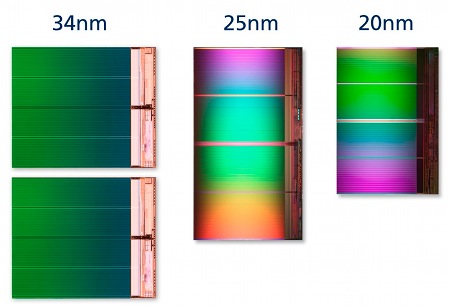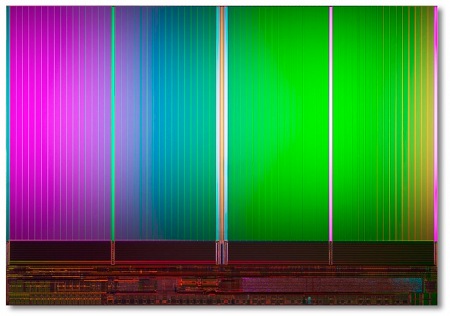Yet again, flash memory shrinks
Apr 14, 2011 — by LinuxDevices Staff — from the LinuxDevices Archive — 1 viewsIntel and Micron announced they've begin sampling 20-nanometer NAND flash technology, which will enable mobile devices and SSD (solid-state disks) to pack significantly more memory. Manufactured by the joint venture IM Flash Technologies, the process will lower costs and use 30 to 40 percent less space inside devices, according to the companies.
According to Intel and Micron, the first product of their 20nm process is an 8GB NAND device measuring just 118 square millimeters. The image below dramatizes progress relative to the 25nm device the companies introduced just last year: It shows two 34nm chips at left, a 25nm chip in the middle, and the new 20nm device at right — all holding the same 8GB of storage.

The same 8GB of storage in two 34nm chips (left), one 25nm chip (middle), and one 20nm chip (right)
(Click to enlarge)
Shrinking NAND lithography is the most cost-effective method of increasing fab output, and thereby lowering the cost of flash, say Intel and Micron. It also benefits device designers, since it enables a 30 to 40 percent reduction in the board space occupied by memory, the companies add.

The 20nm, 8GB NAND die from Intel and Micron
(Click to enlarge even further)
Tom Rampone, vice president and general manager of Intel's Non-Volatile Memory Solutions Group, stated, "Industry-leading NAND gives Intel the ability to provide the highest quality and most cost-effective solutions to our customers, generation after generation. The Intel-Micron joint venture is a model for the manufacturing industry as we continue to lead the industry in process technology and make quick transitions of our entire fab network to smaller and smaller lithographies."
Intel and Micron formed IM Flash Technologies (IMFT) in 2006, and appear to have doubled NAND flash density roughly every 16 months. Production started with a 50nm process, eventually pushed to read speeds of up to 200MB/sec., and was followed by a 34nm process in 2008.
Availability
According to Intel and Micron, their 20nm, 8GB NAND flash die is sampling now and is expected to enter mass production in the second half of this year. Around that same time, a 16GB version will begin sampling, the companies added.
Jonathan Angel can be followed at www.twitter.com/gadgetsense.
This article was originally published on LinuxDevices.com and has been donated to the open source community by QuinStreet Inc. Please visit LinuxToday.com for up-to-date news and articles about Linux and open source.